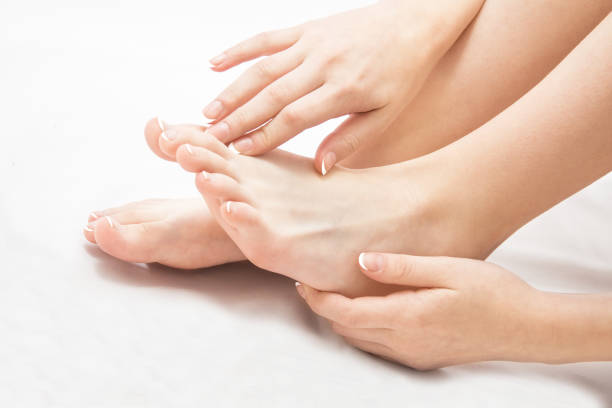
Your feet do a lot of work. By age 50, they’ve probably logged 75,000 miles.
A podiatrist is trained to treat all kinds of foot problems. They have four years of schooling at a podiatric medical school and hospital-based residency training.
They can help with: swollen ankles, flat feet, hammertoes, ingrown toenails and fungus on the feet. They can also give you stretches and exercises to strengthen your feet.
1. Blisters
A blister is a raised bump filled with clear fluid or, occasionally, blood. It may be painful or itchy, and can occur anywhere on the body. Blisters occur when the outer layer of skin separates from the layer beneath it, creating a gap that fills with fluid. Blisters can be caused by friction (rubbing or pressure), heat, burns, frostbite, or an underlying health condition.
The most common cause of blisters is friction from shoes. People who spend a lot of time on their feet, such as runners or hikers, are at particular risk for blistering. It is also possible to get blisters from other activities, such as working with tools like pruners or strong pliers, or sitting on hard surfaces for long periods of time.
Friction blisters are most often found on the feet, but can appear anywhere on the body. They develop when the skin is exposed to constant rubbing or pressure and the outer layers of skin break apart, creating a pocket that is filled with clear fluid or, in some cases, blood.
Most blisters don’t require medical attention unless they are severe, recurrent, or caused by burns. However, if a blister is very painful or itchy, see a doctor for treatment. Blisters should never be popped or burst, as this increases the risk of infection and can hinder the healing process. Instead, a doctor can sterilize a needle and pierce the blister at one edge to drain it.
Blisters are more likely to form in areas of the foot where there is pressure or friction, such as on the bottoms of the feet, between the toes, or under the balls of the feet. To prevent blisters, wear soft footwear that fits well and use padding to protect problem areas. Also, avoid excessive rubbing or friction and apply lotion to the feet frequently.
2. Bunions
A bunion (hallux valgus) is a painful bump that develops on the inside of your big toe joint. It causes your big toe to bend toward the second toe, forming a bony bump that looks like a turnip. Bunions are more common in women than men, probably because many women wear narrow shoes with pointed toes that force the toes to crush together and accelerate the growth of a bunion. Bunions also tend to run in families, possibly due to genetics affecting the shape of your foot or joints. People with flat feet or rheumatoid arthritis also have a higher risk of developing bunions.
Bunions are caused by pressure on the big toe joint, called the metatarsophalangeal (MTP) joint. When this pressure becomes excessive, the MTP joint swells and a bunion forms. Symptoms of a bunion include pain at the base of your big toe, redness and swelling in the skin over the bump and a callus or hard corn that forms on the bump. Some bunion symptoms are mild and may resolve with nonsurgical treatment. More severe symptoms can get progressively worse over time and require surgery.
Nonsurgical treatments for bunions include wearing shoes that fit well and using pads or splints to take pressure off the toe. If these do not relieve the symptoms, a podiatrist may recommend surgery to remove the bunion and realign the toe and foot. This procedure is called a bunionectomy. It’s usually performed under local anesthesia and does not require a hospital stay. However, it can involve a longer recovery period than other types of foot surgeries. Your podiatrist will discuss your surgical options with you. They will examine your feet and x-rays before deciding on the best course of action for you.
3. Calluses
Corns and calluses are thickened areas of skin that develop in response to repeated rubbing (friction) or pressure. They often form on the feet (heels, ball of foot area, toes, and knuckles), although they can also appear on the hands. They usually appear yellowish or grayish in color and may feel bumpy to the touch. They are less sensitive than the surrounding skin and are not painful unless they become very thick.
Both corns and calluses are called keratotic lesions, but there is a difference between the two. A callus is a larger patch of thick skin that may appear anywhere on the bottom of your foot, while a corn has a hard center surrounded by swollen skin.
Treatments for calluses and corns include the use of a commercial product that contains an acid, such as salicylic acid, to thin the layers of skin. These products are available as creams, ointments, and gels. However, if you have poor circulation in your feet or have diabetes, talk to your podiatrist before trying these treatments at home.
Your podiatrist will examine your feet, examining the skin where corns and calluses have developed. They will ask about your symptoms and medical history, watch you walk, and take X-rays if necessary.
If your corns or calluses don’t respond to home treatment, your podiatrist might suggest removing them surgically. This is typically done by using a sharp blade to pare away the thickened area of skin. This is painless and shouldn’t require a hospital stay. Your podiatrist will also advise you on how to prevent your corns and calluses from returning, including appropriate padding and wearing shoes that fit well.
4. Hammertoes
Hammertoes develop as a result of the imbalance of muscles, tendons and ligaments that support your toes and keep them straight. They usually start in the second toe, but they can affect any of your lesser toes. You can usually tell if you have them by the claw-like shape of the toe. Your podiatrist will diagnose them by doing a physical exam of your foot and toes, moving them and seeing how they respond. They may also need to do X-rays to get more detailed information about your toe joints and bones. They will ask you about your symptoms and may need to do further tests if you have diabetes, because hammertoes can become a serious problem if not treated properly to reduce pressure on the toe and prevent ulcers.
Your toes have six sets of muscles that work to keep them flat on the ground when you’re walking. This helps prevent them from curling or bending down as you walk. If the muscles are thrown off balance, your toes might develop a hammertoe or mallet toe. This can happen because of wearing shoes that don’t fit you, having a toe injury or a hereditary tendency toward hammertoes.
You can sometimes avoid hammertoes by wearing comfortable shoes and stretching your feet regularly. However, you might need to see a podiatrist Nedlands if the condition gets worse. If left untreated, hammertoes can cause pain and swelling of the affected toe joint and might become stiff and immobile. In some cases, your podiatrist might need to perform a procedure called a hammertoe procedure, which involves cutting and removing the bony bumps from the bottom of your toe joint, straightening and realigning the toe to correct its position and then putting a steel pin or a screw in the toe joint to hold it in place.
5. Neuromas
Neuromas are areas of painful, disorganized nerve tissue. They occur when injured nerve ends regenerate in an uncontrolled way, disrupting the normal linear organization of the fibers and resulting in an abnormal mass of fibrous tissue that creates and transmits signals that the central nervous system interprets as pain. Neuromas most commonly occur between the third and fourth toes in one or both feet, although they can also be found between the second and fifth toes or in the heel area.
There are several causes of neuromas, but the most common is wearing shoes that squeeze or compress the toes. High-heeled shoes and other types of shoes with tapered or narrow toe boxes force the toes together, putting pressure on all sides of the nerves. Certain foot conditions, such as bunions, flat feet, and hammertoes, can also increase your risk of developing neuromas.
Symptoms of neuromas include a sharp or burning pain in the ball of your foot, between your toes. The pain may come and go, or it may be constant. You may also feel a tingling sensation in the balls of your feet.
A podiatrist can diagnose a neuroma through history and examination. They can do what’s called the Tinel test, in which they tap on the path of the suspected nerve to see if it causes pain or tingling. They might also do an X-ray, ultrasound, or magnetic resonance imaging (MRI) to visualize the area. In general, the earlier a neuroma is diagnosed, the more effective nonsurgical treatment can be. This includes icing the area, wearing padding, and modifying activities that put stress on the toes. Surgical options are only recommended if nonsurgical treatments fail to relieve symptoms or when the neuroma is severe.





